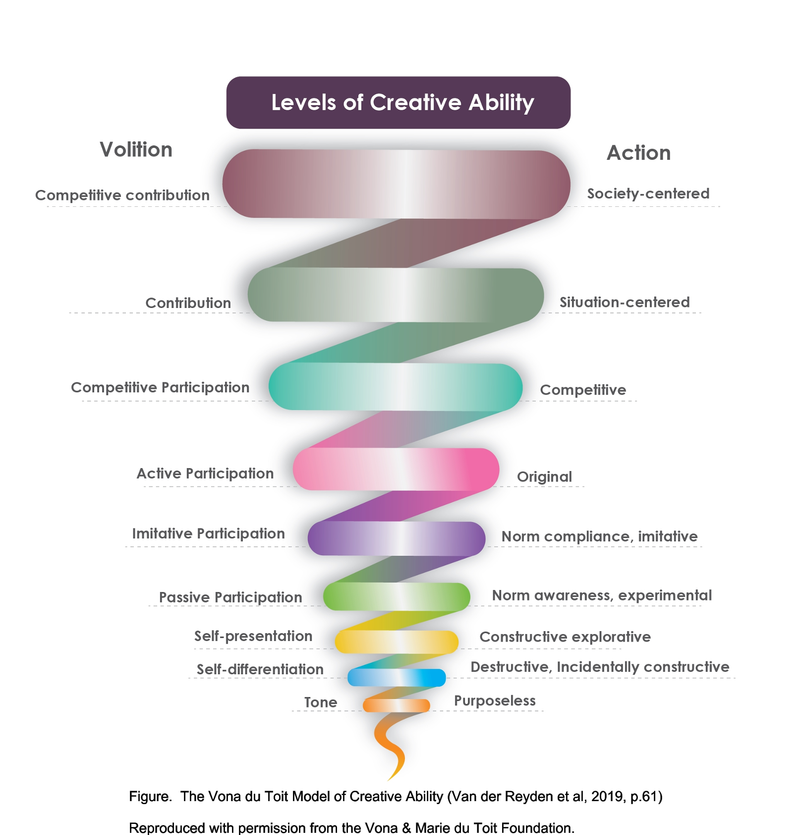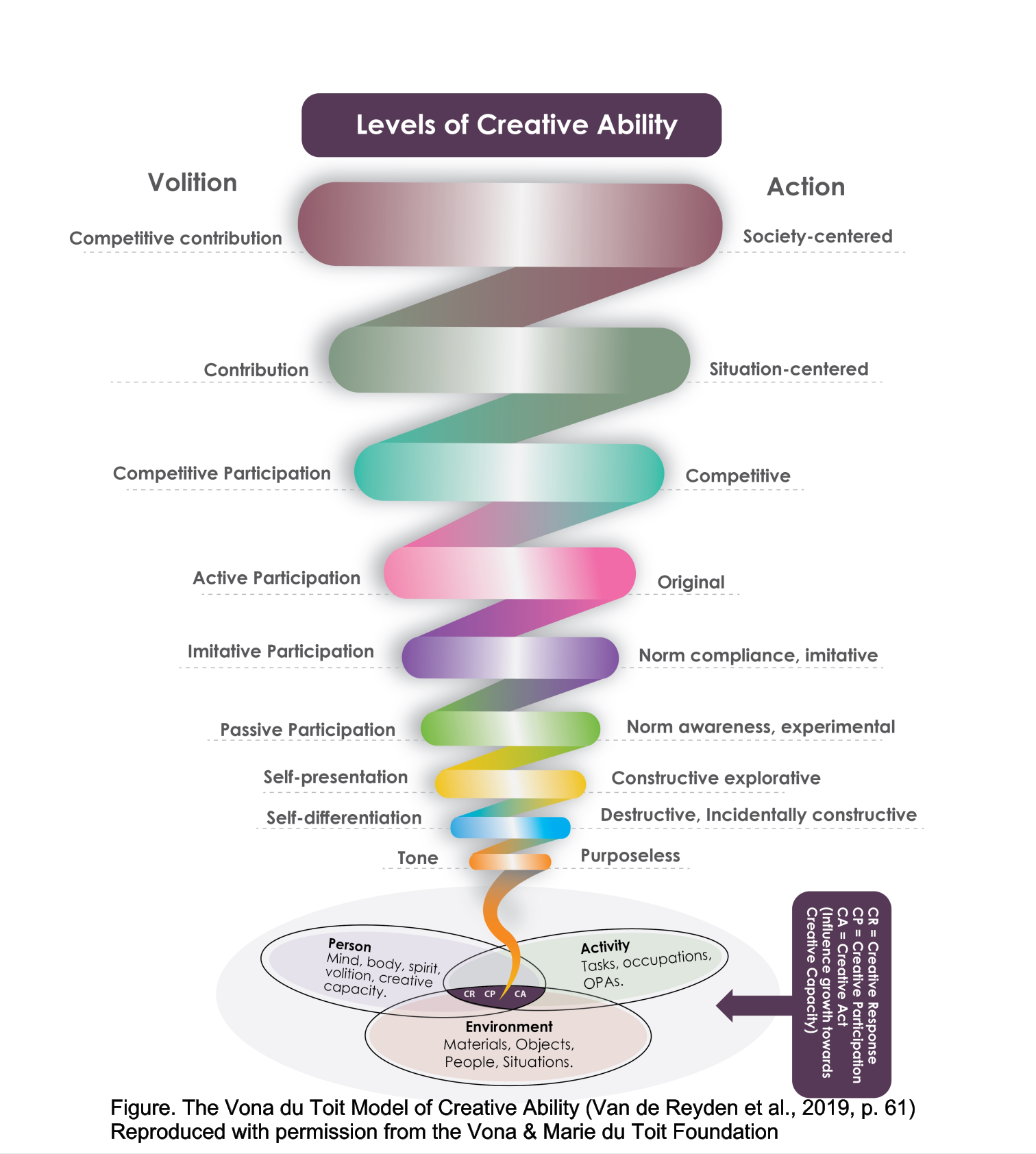The VdTMoCA in detail

The VdTMoCA constructs and graphic
Creative ability is a specific term/concept as defined in the VdTMoCA. It does not mean the ability to be artistic or to be imaginatively expressive etc, as per the common use of the term creative. To be ‘creative’ means having the ability to create - to bring about something new (to you), but this isn’t limited to creating (making) artistic or imaginative things/products.
Creating, bringing about something new occurs in the face of a challenge, demand or opportunity to create - you can’t do or haven't already done something, or you don’t yet have the knowledge/understanding about something, or you haven’t yet created a specific tangible thing. In encountering this, you have a choice about how to respond.
You can avoid it, not engage, watch but not actually do, or put in minimal effort (could do more/try harder but decide not to/can’t be bothered) - these are not creative responses - these will not result in creating and experiencing oneself as bringing something into being through one's own efforts - there is no "I CAN" moment.
Alternatively, your response is a creative response - a preparedness to participate, try, engage, do with effort. How much effort one puts in (actively engages, tries), reflects and is driven by one's strength of volition and motivation. This is seen in the quality of your action. For example, you can tentatively and fleetingly connect with/have a go at whatever it is, or you can put in effort and engage with your full attention and intention, you can give up when the task/situation/demand is difficult or not going well or can persist/sustain effort to the end and complete the task/master the challenge, or you can achieve this with maximum effort - mustering everything you’ve got.
How you respond in terms of quality of the strength of your volition (will) and motivation (desire to do) which drives your action, and the result of that (the end-product/what is created) is evidence of your creative ability.
“Creative ability is the manifestation of one’s motivation in action resulting in a tangible or intangible product, which is directed by volition - the will to be and to direct one’s own life” (Van der Reyden & Sherwood, 2019, p. 64).
Your creative ability emerges from the intersection of person, activity/occupation and environment (PEO) (the base of the model graphic -above). In occupational therapy, this intersection is commonly referred to as occupational performance. In the VdTMoCA, it is this also but more - it’s your creative ability within your performance.
Being creative necessitates that, in the face of a challenge, you make a creative response (CR), (a positive attitudinal reaction; a preparedness to doing), which may lead to creative participation (CP) (active engagement with the exertion of effort in order to meet and/or master challenges), culminating in the creative act (CA) (creation of something new), and ultimately, growth in creative ability (Van der Reyden & Sherwood, 2019; Vona du Toit, 1974).
The graphic illustrates that creative ability emerges from the P-E-O intersection (the tip of the spiral), and grows/develops upwards in breadth and depth. The spiral loops “reflect the interrelatedness (intertwined nature) of volition, motivation and action at each sequential level of creative ability, each expanding exponentially on the previous level” (Van der Reyden & Sherwood, 2019, p.63).

Each level of creative ability has both volition and action components. The first volitional level is Tone (to exist, have biological tone, survive), corresponding to Purposeless and unplanned action (e.g., reflexive, to meet biological and safety needs), followed by the Self-differentiation volitional level (to differentiate the self as separate from other things), with its corresponding action which is Destructive/Incidentally constructive, and so on. The levels are described in detail by Casteleijn & Holsten in Van der Reyden et al. (2019).
The levels represent the developmental potential across the lifespan, starting at the Tone level of creative ability. Hence, the VdTMoCA draws upon a developmental frame of reference, and incorporates various theories regarding human development and motivation (e.g. Piaget, Maslow) as well as philosophical perspectives including existentialism (e.g., Buber) and phenomenology. Therefore, human beings are viewed as a totality of mind, body and spirit (spirituality and volition), with an inherent need to create (we are all creative with a need to make contact with, form relations with the world around us and act on it/do, to master challenges). This need seeks expression.
One’s need to create (motivation driven by volition) is expressed in action, and is therefore observable. We observe what an individual does, how they go about it (quality, strength of volition) and the resulting end product. This provides an indication of his/her/their level of creative ability.
For each level, the VdTMoCA provides detailed guidance on how to select, grade and facilitate activities and activity participation so that they are within the person’s ability, but spark their volition (is matched to the volitional need), and has the just right challenge. Meeting the challenge through effort, experiencing satisfying activity participation and a satisfying end-product (tangible or intangible), potentially results in growth/recovery of creative ability.